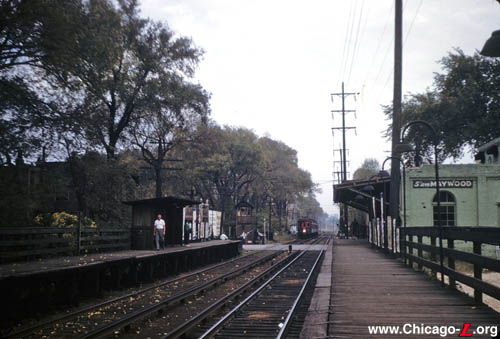|

The 5th Avenue station is seen looking east on the inbound platform circa 1952, shortly after "L" service was withdrawn west of Desplaines. An outbound CA&E interurban train is approaching the station. The station house on the right served the facility. Note the hinged flaps on the edge of the platforms, which would be flipped up to allow wider freight trains to clear the platforms. For a larger view, click here. (Photo by Robert V. Mehlenbeck, courtesy of the Krambles-Peterson Archive)
|
5th Avenue
(500W/1400S)
5th Avenue near Quincy
Street, Village of Maywood
Service
Notes:

|
Westchester
Line
|
Quick Facts:
Address: TBD
Established: |
August 25, 1902 (AE&C interurban service
inaugurated) |
October 1, 1926 ("L" service
inaugurated) |
Original Line: |
Aurora, Elgin & Chicago Railway (interurban service) |
Metropolitan West Side Elevated, Westchester
branch("L" service) |
Previous Names: Maywood
Skip-Stop Type: n/a
Rebuilt: n/a
Status: Demolished
History:
5th Avenue opened in 1902 as part of the Aurora, Elgin and Chicago (AE&C) interurban's line between the Fox River Valley and 52nd Avenue in Chicago. A few years later, AE&C trains operated into Downtown Chicago using trackage rights over the Garfield Park branch of the Metropolitan West Side Elevated.
5th Avenue was built with two low-level side platforms on the west side of the street. The facility featured a masonry building adjacent to the inbound platform which housed both the station facility and ticket office as well as electrical substation #4 of the interurban. The outbound platform, which had more alighting passengers, had only a waiting shelter.
In the mid-1920s, the Chicago
Aurora & Elgin interurban planned to build a high-speed
bypass route for their trains through the western suburbs. Designed
to leave the CA&E main line just east of their existing Bellwood station at Bellwood
Avenue, the branch was to go south to Cermak Road, then turn west to
rejoin the CA&E Aurora branch near Warrenville. The only section to be built was what
became the Westchester
branch, which opened as a one-mile spur from Bellwood
Avenue to Roosevelt
Road.
Operation of the Westchester
branch was made the responsibility of the Chicago Rapid Transit
Company, with service beginning on October 1, 1926. The CRT served
the Westchester
branch by extending certain Garfield
Park trains beyond their usual terminal at Desplaines
Avenue. These "L" trains also assumed service to the existing
intermediate stations on the CA&E main line between Desplaines and Bellwood, relieving the interurban of the
obligation to handle this short haul traffic. Upon the inauguration
of "L" service the CA&E ceased serving these stops, except for 5th
Avenue where interurban trains continued to call.
The low-level platforms were later replaced with high-level boarding platforms. While speeding boarding and alighting of trains and reducing dwell times, the high-level platforms hampered the CA&E freight operation's hauling of railroad freight cars, whose width and clearance were often in excess of the "L" and interurban cars resulting in their inability to clear normal high-level "L" platforms. This problem was solved through the ingenious use of hinged flaps along the edges of the platforms, which were flipped up and out of the way by a brakeman riding the locomotive footboards and flipped back down in place by a man riding the caboose steps. This allowed standard-width railroad freight cars to pass the "L" platforms along this portion of the route.
The hoped-for development of Westchester was
squelched by the Depression just a few years after the line opened. The lots sat empty and streets and sidewalks
slowly deteriorated and became overgrown with weeds. There was little
to feed traffic to the fledgling rapid transit line. Development in
Westchester resumed in 1940, but its pace was still slow and
short-lived, as World War II soon struck and once again put a damper
on major construction. The Chicago Transit Authority assumed
operation of the "L" system in October 1947 and soon after
studied each rapid transit
line and monitored each station. Then, bit by bit, the CTA closed the
stations and lines that were most uneconomical and had the lowest
ridership to concentrate on the stronger routes. The Westchester
branch fell victim to this systematic pruning when on December 9, 1951,
service between Desplaines and 22nd & Mannheim was replaced by the #17 Westchester bus route.
After the "L" ceased serving the 5th Avenue station and the rest of Westchester
branch beyond Desplaines, the CA&E interurban continued serving the station. This continued until July 3, 1957, when passenger service on the CA&E ended without warning to the public at 12:13pm. The station was eventually demolished.



